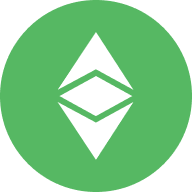سعر Ethereum Classic
في USDنبذة عن Ethereum Classic
الأداء السعري لعملة Ethereum Classic
الأدلة الإرشادية

الأسئلة الشائعة عن Ethereum Classic
تعمق أكثر في Ethereum Classic
Ethereum Classic (ETC) هي عملة رقمية لامركزية تستفيد من تقنية البلوكتشين لإجراء المعاملات الآمنة.
لماذا تستثمر في Ethereum Classic (ETC)؟
لأن Ethereum Classic عملة لامركزية غير خاضعة لسيطرة الحكومة أو المؤسسات المالية، فهي بكل تأكيد بديلٌ للعملات النقدية التقليدية. مع ذلك، فإن الاستثمار في Ethereum Classic أو تداولها أو شرائها ينطوي على تعقيداتٍ وتقلُّباتٍ في السعر، لذا فإن البحث الشامل والوعي بالمخاطر أمران ضروريان قبل الاستثمار. اعرف المزيد عن أسعار Ethereum Classic (ETC) والمزيد من المعلومات عنها هنا على منصة OKX.
كيف يُمكِنك شراء ETC وتخزينها؟
لشراء ETC وتخزينها، يُمكِنك شراؤها من إحدى منصات تداول العملات الرقمية أو من خلال متجر التداوُل من نظير إلى نظير. وبعد شراء ETC، من الضروري تخزينها بشكل آمن في إحدى محافظ العملات الرقمية التي تأتي بنوعين: محافظ للعملات الرقمية متصلة بالإنترنت (قائمة على البرمجيات وتُخزَّن على أجهزتك) ومحافظ للعملات الرقمية غير متصلة بالإنترنت (قائمة على الأجهزة وتُخزَّن دون الاتصال بالإنترنت).
إخلاء المسؤولية
لا تقدم OKX أي توصيات بشأن الاستثمار أو الأصول. يجب عليك التفكير بعناية كون تداول الأصول الرقمية أو امتلاكها مناسبًا لك حسب وضعك المالي أم لا. يُرجى استشارة خبير شؤون قانونية أو ضرائب أو استثمار بخصوص أي أسئلة متعلقة بظروفك الخاصة. لمزيد من التفاصيل، يُرجى الرجوع إلى شروط الاستخدام وتحذير المخاطر. من خلال استخدام الموقع الإلكتروني التابع لطرف ثالث ("TPW")، أنت تقرّ بأن أي استخدام لهذا الموقع سيكون خاضعًا لشروط وأحكام الموقع ذاته وتابعًا له. ما لم يُذكر بشكل صريح ومكتوب، فإن منصة OKX والشركات التابعة لها ("OKX") غير مرتبطة بأي شكل من الأشكال بمالك أو مشغّل الموقع التابع لطرف ثالث. أنت توافق على أن OKX غير مسؤولة عن أي خسارة أو ضرر أو أي تبِعات أخرى تنشأ عن استخدامك للموقع التابع لطرف ثالث. يُرجى العلم أن استخدام موقع تابع لطرف ثالث قد يؤدي إلى خسارة أصولك أو نقصانها. قد لا تتوفر الخدمة في جميع الولايات القضائية.



































